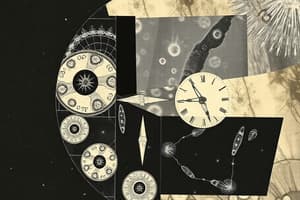Podcast
Questions and Answers
What distinguishes the cell cycle of eukaryotes from that of prokaryotes?
What distinguishes the cell cycle of eukaryotes from that of prokaryotes?
- Eukaryotes have a simpler chromosome structure.
- Prokaryotes have multiple chromosomes in a nucleus.
- Eukaryotes possess multiple linear chromosomes within a nucleus. (correct)
- Eukaryotes divide through binary fission.
What is the role of checkpoints in the cell cycle?
What is the role of checkpoints in the cell cycle?
- They produce spindle fibers for mitosis.
- They trigger the replication of DNA.
- They regulate the rate of cell division. (correct)
- They initiate cytokinesis.
During which phase of the cell cycle are errors in new DNA repaired?
During which phase of the cell cycle are errors in new DNA repaired?
- G2 phase (correct)
- M phase
- G1 phase
- S phase
What is the function of spindle fibers during mitosis?
What is the function of spindle fibers during mitosis?
What happens to chromosomes during the S phase of the cell cycle?
What happens to chromosomes during the S phase of the cell cycle?
What defines a cancerous tumor as malignant?
What defines a cancerous tumor as malignant?
What occurs during telophase of mitosis?
What occurs during telophase of mitosis?
How many chromosomes are present in a human zygote?
How many chromosomes are present in a human zygote?
Flashcards are hidden until you start studying
Study Notes
Cell Cycle
- The cell cycle describes how eukaryotic cells divide.
- Eukaryotes have a nucleus containing multiple linear chromosomes, while prokaryotes have a single looped chromosome outside of a nucleus.
- Humans have 46 chromosomes in most cells, with half coming from each parent.
- The cell cycle is divided into two main phases: interphase and mitosis.
Interphase
- Interphase is the longest phase of the cell cycle, when the cell grows and prepares for division.
- Interphase consists of three subphases: G1, S, and G2.
- G1 (Gap 1) is the initial growth phase where organelles are produced.
- S (Synthesis) is the phase where DNA replicates, doubling the number of chromosomes.
- G2 (Gap 2) is the phase where errors in the newly synthesized DNA are repaired.
Mitosis
- Mitosis is the division of the nucleus, ensuring each daughter cell receives a complete set of chromosomes.
- Mitosis begins with a diploid (2N) number of chromosomes and ends with two identical diploid cells.
- Mitosis is not the entire cell cycle, it's just a part of it.
- Mitosis involves four main phases: prophase, metaphase, anaphase, and telophase.
- Prophase: Chromosomes condense and move towards the center of the cell.
- Metaphase: The chromosomes align randomly along the middle of the cell, and spindle fibers form.
- Anaphase: Spindle fibers attach to the centromere of the chromosomes, pulling them apart to opposite sides of the cell.
- Telophase: The cell begins to pinch in, the nucleus reforms, and in plant cells, a cell plate forms to separate the daughter cells.
Terms & Definitions
- Cytokinesis: The division of the cytoplasm following nuclear division.
- Homologous Chromosomes: Identical chromosomes, one from each parent, with the same size and genes.
- Centromere: The central part of a chromosome where sister chromatids are joined.
- Sister Chromatids: The original chromosome and its copy made during the S phase of interphase.
Meiosis
- Meiosis is a type of cell division that produces four haploid (N) daughter cells from a diploid (2N) parent cell.
- It involves two rounds of division, resulting in gametes (sex cells).
- Prophase I is unique to meiosis and involves crossing over, which creates genetic diversity.
- The random alignment of chromosomes during meiosis also contributes to genetic diversity.
Stem Cells
- Stem cells are undifferentiated cells that can develop into various cell types.
- Embryonic stem cells are more responsive to programming than adult stem cells.
- Stem cell research is controversial because some people believe it involves aborted fetal tissue, however, this is not true.
Cancer
- Uncontrolled cell division can lead to cancer.
- Tumors are abnormal growths of cells.
- Malignant tumors are cancerous and can metastasize (spread to other tissues).
- Benign tumors are not cancerous and do not spread.
Studying That Suits You
Use AI to generate personalized quizzes and flashcards to suit your learning preferences.




